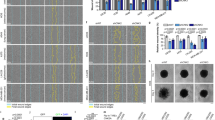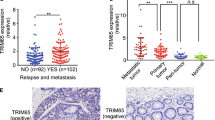Abstract
The small GTPase Rac1 is a key regulator of cell motility. Multiple mechanisms regulate Rac1 activity including its ubiquitylation and subsequent degradation. Here, we identify the tumour suppressor HACE1 (HECT domain and Ankyrin repeat Containing E3 ubiquitin-protein ligase 1) as an E3 ubiquitin ligase responsible for Rac1 degradation following activation by a migration stimulus. We show that HACE1 and Rac1 interaction is enhanced by hepatocyte growth factor (HGF) signalling, a Rac activator and potent stimulus of cell migration. Furthermore, HACE1 catalyses the poly-ubiquitylation of Rac1 at lysine 147 following its activation by HGF, resulting in its proteasomal degradation. This negative feedback mechanism likely restricts cell motility. Consistent with this, HACE1 depletion is accompanied by increased total Rac1 levels and accumulation of Rac1 in membrane ruffles. Moreover, HACE1-depletion enhances cell migration independently of growth factor stimulation, which may have significance for malignant conversion. A non-ubiquitylatable Rac1 rescues the migration defect of Rac1-null cells to a greater extent than wild-type Rac1. These findings identify HACE1 as an antagonist of cell migration through its ability to degrade active Rac1.
This is a preview of subscription content, access via your institution
Access options
Subscribe to this journal
Receive 50 print issues and online access
$259.00 per year
only $5.18 per issue
Buy this article
- Purchase on Springer Link
- Instant access to full article PDF
Prices may be subject to local taxes which are calculated during checkout




Similar content being viewed by others
References
Etienne-Manneville S, Hall A . Rho GTPases in cell biology. Nature 2002; 420: 629–635.
Bustelo XR, Sauzeau V, Berenjeno IM . GTP-binding proteins of the Rho/Rac family: regulation, effectors and functions in vivo. Bioessays 2007; 29: 356–370.
Visvikis O, Lores P, Boyer L, Chardin P, Lemichez E, Gacon G . Activated Rac1, but not the tumorigenic variant Rac1b, is ubiquitinated on Lys 147 through a JNK-regulated process. Febs J 2008; 275: 386–396.
Lynch EA, Stall J, Schmidt G, Chavrier P, D'Souza-Schorey C . Proteasome-mediated degradation of Rac1-GTP during epithelial cell scattering. Mol Biol Cell 2006; 17: 2236–2242.
Nethe M, Anthony EC, Fernandez-Borja M, Dee R, Geerts D, Hensbergen PJ et al. Focal-adhesion targeting links caveolin-1 to a Rac1-degradation pathway. J Cell Sci 2010; 123: 1948–1958.
Castillo-Lluva S, Tatham MH, Jones RC, Jaffray EG, Edmondson RD, Hay RT et al. SUMOylation of the GTPase Rac1 is required for optimal cell migration. Nat Cell Biol 2010; 12: 1078–1085.
Doye A, Boyer L, Mettouchi A, Lemichez E . Ubiquitin-mediated proteasomal degradation of Rho proteins by the CNF1 toxin. Methods Enzymol 2006; 406: 447–456.
Torrino S, Visvikis O, Doye A, Boyer L, Stefani C, Munro P et al. The E3 Ubiquitin-Ligase HACE1 Catalyzes the Ubiquitylation of Active Rac1. Dev Cell 2011; 21: 959–965.
Anglesio MS, Evdokimova V, Melnyk N, Zhang L, Fernandez CV, Grundy PE et al. Differential expression of a novel ankyrin containing E3 ubiquitin-protein ligase, Hace1, in sporadic Wilms' tumor versus normal kidney. Hum Mol Genet 2004; 13: 2061–2074.
Gentile A, Trusolino L, Comoglio PM . The Met tyrosine kinase receptor in development and cancer. Cancer Metastasis Rev 2008; 27: 85–94.
Hays JL, Watowich SJ . Oligomerization-induced modulation of TPR-MET tyrosine kinase activity. J Biol Chem 2003; 278: 27456–27463.
Doye A, Mettouchi A, Bossis G, Clement R, Buisson-Touati C, Flatau G et al. CNF1 exploits the ubiquitin-proteasome machinery to restrict Rho GTPase activation for bacterial host cell invasion. Cell 2002; 111: 553–564.
Zhang L, Anglesio MS, O'Sullivan M, Zhang F, Yang G, Sarao R et al. The E3 ligase HACE1 is a critical chromosome 6q21 tumor suppressor involved in multiple cancers. Nat Med 2007; 13: 1060–1069.
Del Pozo MA, Alderson NB, Kiosses WB, Chiang HH, Anderson RG, Schwartz MA . Integrins regulate Rac targeting by internalization of membrane domains. Science 2004; 303: 839–842.
Del Pozo MA, Kiosses WB, Alderson NB, Meller N, Hahn KM, Schwartz MA . Integrins regulate GTP-Rac localized effector interactions through dissociation of Rho-GDI. Nat Cell Biol 2002; 4: 232–239.
Vidali L, Chen F, Cicchetti G, Ohta Y, Kwiatkowski DJ . Rac1-null mouse embryonic fibroblasts are motile and respond to platelet-derived growth factor. Mol Biol Cell 2006; 17: 2377–2390.
Trahey M, McCormick F . A cytoplasmic protein stimulates normal N-ras p21 GTPase, but does not affect oncogenic mutants. Science 1987; 238: 542–545.
Garcia-Mata R, Wennerberg K, Arthur WT, Noren NK, Ellerbroek SM, Burridge K . Analysis of activated GAPs and GEFs in cell lysates. Methods Enzymol 2006; 406: 425–437.
Oberoi TK, Dogan T, Hocking JC, Scholz RP, Mooz J, Anderson CL et al. IAPs regulate the plasticity of cell migration by directly targeting Rac1 for degradation. EMBO J 2012; 31: 14–28.
Acknowledgements
This work was supported by Cancer Research UK grant number C147/A12328 and the Association for International Cancer Research grant number 12-0037 to AM. SCL was additionally supported by an EMBO long-term fellowship. Also this work was supported in part by funds to PHBS from the British Columbia Cancer Foundation through generous donations from Team Finn and other riders in the Ride to Conquer Cancer. MD was supported by The Danish Cancer Society Scientific Committee (grant number R2-A189-B146). We thank Dr Trusolino, Dr Sánchez-Madrid and Dr Vidali for reagents, Dr Hurlstone and Dr Wilkinson for critical reading of the manuscript.
Author information
Authors and Affiliations
Corresponding author
Ethics declarations
Competing interests
The authors declare no conflict of interest.
Additional information
Supplementary Information accompanies the paper on the Oncogene website
Supplementary information
Rights and permissions
About this article
Cite this article
Castillo-Lluva, S., Tan, CT., Daugaard, M. et al. The tumour suppressor HACE1 controls cell migration by regulating Rac1 degradation. Oncogene 32, 1735–1742 (2013). https://doi.org/10.1038/onc.2012.189
Received:
Revised:
Accepted:
Published:
Issue Date:
DOI: https://doi.org/10.1038/onc.2012.189
Keywords
This article is cited by
-
Key role of Rho GTPases in motor disorders associated with neurodevelopmental pathologies
Molecular Psychiatry (2023)
-
Optineurin links Hace1-dependent Rac ubiquitylation to integrin-mediated mechanotransduction to control bacterial invasion and cell division
Nature Communications (2022)
-
HACE1-mediated NRF2 activation causes enhanced malignant phenotypes and decreased radiosensitivity of glioma cells
Signal Transduction and Targeted Therapy (2021)
-
HACE1 blocks HIF1α accumulation under hypoxia in a RAC1 dependent manner
Oncogene (2021)
-
Interferon-stimulated gene 15 modulates cell migration by interacting with Rac1 and contributes to lymph node metastasis of oral squamous cell carcinoma cells
Oncogene (2019)



